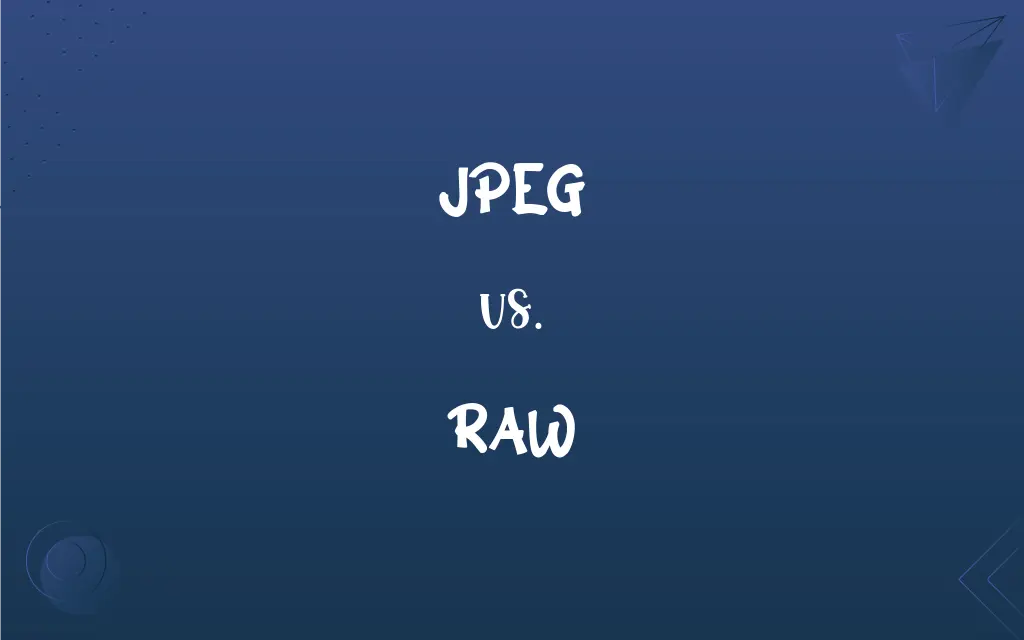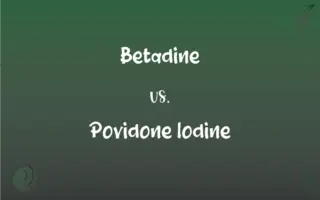JPEG vs. RAW: What's the Difference?
Edited by Aimie Carlson || By Janet White || Published on February 9, 2024
JPEG is a widely-used compressed image format with loss of quality, while RAW is an uncompressed, full-quality image format typically used in photography.

Key Differences
JPEG files are compressed, resulting in smaller file sizes and some loss of image quality. RAW files are uncompressed, retaining all image data and thus have much larger file sizes.
JPEG images have lower quality due to compression, limiting post-processing flexibility. RAW images offer higher quality and greater flexibility in editing, as they contain all the data captured by the camera sensor.
JPEG is a universal format, widely supported across devices and software. RAW is a format specific to camera manufacturers and requires specialized software for viewing and editing.
JPEGs are processed and color-corrected in-camera, ready for immediate use. RAW files are unprocessed, requiring additional time and software for post-processing.
JPEG is suitable for general use, web sharing, and when storage space is limited. RAW is preferred by professional photographers for high-quality prints and detailed post-production work.
ADVERTISEMENT
Comparison Chart
File Size
Smaller, due to compression
Larger, contains more image data
Image Quality
Lower, due to compression artifacts
Higher, captures full image data
Editing Flexibility
Limited, less data for post-processing
High, more data available for editing
Compatibility
Widely supported across devices and software
Requires specific software for editing and viewing
Processing
Processed and color-corrected in-camera
Requires post-processing for optimal results
ADVERTISEMENT
Storage Considerations
More efficient for storage
Requires more storage space
JPEG and RAW Definitions
JPEG
JPEG images support a limited color range.
The vibrant colors were slightly muted in the JPEG version.
RAW
RAW format is preferred by professional photographers.
For her professional shoots, she always prefers RAW for the best image quality.
JPEG
It is widely used for digital photography and online images.
Most images on the website were in JPEG format for quick loading.
RAW
RAW files are large and require more storage space.
Storing RAW photos required him to invest in additional hard drives.
JPEG
JPEG is a popular compressed image file format.
He saved the photo as a JPEG to reduce its size for email.
RAW
RAW images are not processed and need to be edited.
After shooting in RAW, she spent time color grading her photos.
JPEG
JPEG files are smaller and have some quality loss.
The JPEG image showed slight pixelation compared to the original.
RAW
It provides high-quality images with extensive editing capabilities.
The RAW file allowed her to adjust exposure and shadows in post-processing.
JPEG
JPEG is ideal for quick sharing and limited storage.
For her blog, she used JPEGs to save space and bandwidth.
RAW
RAW is a file format that captures all image data recorded by the camera sensor.
He always shoots in RAW to have maximum control during editing.
JPEG
A standard algorithm for the compression of digital images.
JPEG
A digital image stored as a file so compressed
A JPEG of a cat.
JPEG
Alternative case form of JPEG
JPEG
A standardized format for storing graphic data in binary computer files, allowing over 16 million different colors. It allows for lossy compression, i. e. the compression of data into a form which re-expands into an image close, but not identical to the original image. Files stored in this format usually carry the extension jpg or jpeg. Compare GIF.
FAQs
Are JPEG files small in size?
Yes, JPEG files are typically smaller due to their compression method, which makes them convenient for sharing and storing.
Do JPEG files lose quality?
Yes, each time a JPEG is saved, it loses some quality due to its lossy compression.
Can I edit JPEG files?
Yes, but repeated editing and saving can degrade image quality over time.
What is a JPEG?
JPEG is a widely used format for digital photography, known for its efficient compression of image data.
How does JPEG compression work?
JPEG uses lossy compression, reducing file size by permanently removing certain image details.
Can JPEG support transparency?
No, JPEG format does not support transparent backgrounds.
How is RAW different from JPEG?
RAW files are uncompressed and contain more data, offering higher quality and more flexibility in editing than JPEG.
What devices use JPEG?
Most digital cameras, smartphones, and web platforms support JPEG.
Can I print JPEG photos?
Yes, but the print quality depends on the original file's resolution and size.
Is JPEG suitable for professional photography?
It's used in professional settings but might not be ideal for high-quality prints or extensive editing.
Can I print directly from RAW files?
No, RAW files need to be converted to a printable format like JPEG or TIFF.
Are RAW files large?
Yes, they are significantly larger than JPEG files due to the amount of data they contain.
Do RAW files lose quality?
No, RAW files maintain original quality as they are not subject to lossy compression.
What devices capture RAW images?
Many digital cameras and some smartphones can shoot in RAW.
Are RAW files good for web use?
Not directly, as their size makes them impractical for web use. They're typically converted to JPEG for online sharing.
Are JPEGs good for web use?
Absolutely, their small size makes them ideal for websites and online use.
What is a RAW file?
RAW is a file format that captures all image data recorded by the camera sensor during shooting.
Can I edit RAW files easily?
RAW files offer more flexibility in editing, but require specialized software.
Is RAW suitable for all photographers?
It's preferred by professionals and enthusiasts for its high quality and editability, but may be too complex for casual users.
Does RAW format support transparency?
No, RAW format is focused on capturing all image data and does not handle transparency.
About Author
Written by
Janet WhiteJanet White has been an esteemed writer and blogger for Difference Wiki. Holding a Master's degree in Science and Medical Journalism from the prestigious Boston University, she has consistently demonstrated her expertise and passion for her field. When she's not immersed in her work, Janet relishes her time exercising, delving into a good book, and cherishing moments with friends and family.
Edited by
Aimie CarlsonAimie Carlson, holding a master's degree in English literature, is a fervent English language enthusiast. She lends her writing talents to Difference Wiki, a prominent website that specializes in comparisons, offering readers insightful analyses that both captivate and inform.































































